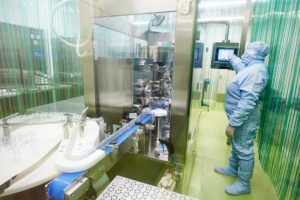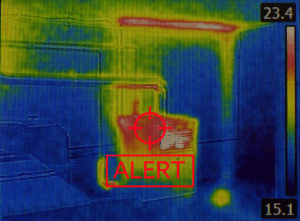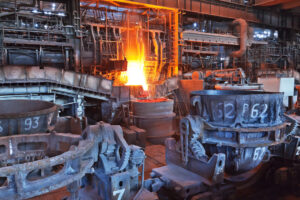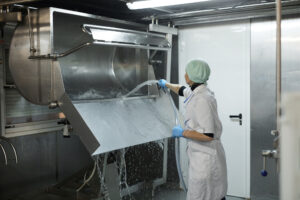It’s hard to imagine a commercial or industrial facility without a video monitoring system today. Cameras are so ubiquitous and they have so many applications that we’ve grown to ignore their presence in most cases.
While the cameras you see in retail establishments and neighbors’ houses are fairly standard pieces of electronic equipment, we can’t say the same about video monitoring systems for industrial applications. Industrial facilities require unique cameras, monitors, and accessories to monitor operations, avoid constant part replacement, and more.
Monitor and Improve Operations with Industrial Video Monitoring Systems
In commercial applications, video monitoring systems are often for security primarily. In industrial applications, however, monitoring and improving operations takes center stage.
By monitoring what happens in your sawmill, mine, food processing plant, or other industrial facility, you can spot processes that can be improved or catch potential equipment failures before they result in accidents or line downtime.
For instance, a log coming down the line sideways or a contaminant about to ruin an entire batch of food—all it takes is a split second. A video operator monitoring the process can catch these things in time to stop the line, send help, and avoid a catastrophe.
A bird’s-eye view of operations can also help identify areas for improvement. In fact, 93% of companies that use video monitoring report an improvement in their operations. Spotting a faulty machine before it wreaks havoc on the entire production line can save you hundreds of thousands of dollars, and improving your facility’s processes can result in savings that add up.
Moreover, you can use video monitoring to improve your employees’ training or to assess performance. Review video feeds to spot accident-prone processes or processes that can be optimized. Then use these insights in your employee training to create a safer and more productive workplace.
Why Industrial Facilities Need Industrial Cameras
This is one of the questions we get very often at Opticom: Why pay a premium for an industrial-grade video monitoring system when off-the-shelf cameras are extremely cheap?
Let’s answer it with an example: Our CC02 camera can withstand the harsh environment of a log debarker. Our sawmill clients have even had their CC02 camera be hit with a log and it kept working. We also ran over one with a truck. Industrial environments are harsh, and video monitoring equipment needs to be built to handle vibration, moisture, temperature changes, debris, and more.
An industrial-grade video monitoring system means:
- You won’t have to replace the cameras every couple of months—even if they are off-the-shelf, affordable cameras, the costs of equipment and downtime add up quickly).
- You have a much lower cost of ownership; since every item in an industrial-grade video monitoring system is rugged and created with durability in mind, they will last for years, not months.
- You’ll have an uninterrupted feed of your operations. This way, you’ll avoid costly downtime, especially in high-risk environments where video monitoring is crucial to ensuring the safety of your staff.
Video Monitoring for Harsh Industrial Environments
Harsh environments—like those in sawmills, mines, food processing plants, and other industrial facilities—come with a unique set of challenges for the electronic equipment you use. This is why you need industrial-grade equipment.
Think about it this way: you wouldn’t use a hand-held mixer designed for home cooking in a food processing plant, would you? You need something that withstands the harsh environment and can work for hours on end.
The same goes for video monitoring systems. Industrial facilities are usually dusty, wet, with high vibrations, poorly lit, noisy, and more. Video cameras are sensitive to all of these factors and so are the other components that go into a video monitoring system.
In a sawmill, for instance, the vibrations can get so intense that they will damage your phone’s camera, even if you keep it in your pocket. Wall-mounted or body cameras are no different—they have sensitive mechanisms that need adequate protection from harsh environments, the kind of protection that their off-the-shelf counterparts don’t have.
Beyond Cameras: Complete Video Monitoring Systems for Industrial Facilities
Cameras may be the most visible part of a monitoring system but they are certainly not the only piece of the puzzle. In industrial applications, the entire system needs to be able to withstand environmental components like shocks and vibrations. This is why camera mounts are such an important part of industrial-grade systems. They absorb the shock so that the camera (the most expensive part of the equipment) stays functional. Similarly, industrial-grade video monitors come with their own set of protective elements, so you can use them on-site in the harshest of conditions.
However, every industrial facility is different and it has different requirements. So it’s important to work with a partner that understands those requirements. For instance, you may not need rugged monitors if your monitoring center is off-site or in a protected area. In this case, it makes no sense to pay for features you don’t use.
Or you may need different types of cameras, ruggedized in different ways for the different areas of your facility or built to specific regulatory standards.
To make sure you get the best ROI from your industrial video monitoring equipment, work with a professional consultant that understands your industry and its particular needs. At Opticom, we have spent the past 50 years working with industrial clients around the world.
We are more than a hardware seller—we are a partner because we understand that our success depends on our clients’ success. If you need help choosing the right industrial video monitoring system, our team of consultants is one click away. We’d be happy to help you make the right choice.







